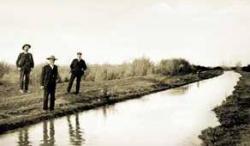
Developed by the Hohokam, a prehistoric group of Native Americans, the canal system in the Salt River Valley serviced more than 100,000 acres of mostly arid desert country in what is now southern Arizona. The prehistoric Hohokam constructed one of the largest and most sophisticated irrigation networks ever created using pre-industrial technology.
The canals were constructed over several hundreds of years. Between AD 600 and AD 700, several major canal systems were constructed. The largest system included a trapezoidal section 13 ft wide x 12 ft deep. Several new canals were constructed between AD 900 and AD 1100. The period between AD 1100 and AD 1450 is considered by archeologists to be the Hohokam's classic period. Sometime around 1450, the Hohokam left the area. In the 1600 and 1700's, early Spanish explorers found the modern Pima Indians on the nearby Gila River still using the Hohokam canal system to irrigate their crops.
The Hohokam canal system is considered to be the largest pre-historic irrigation system in the New World and the oldest irrigation system in the United States. Over 700 miles of major canals were constructed by hand over many centuries without the benefit of modern survey instruments, machinery, or wheeled vehicles. Their major canals averaged about 8 to 12 miles and were largest at the headwaters and tapered throughout their length so that the velocity was maintained between approximately 1.5 and 3 ft per second throughout the system. They were also able to adjust their construction based on the terrain. The Hohokam developed four different types of distribution systems to use depending on the terrain. In addition their system was a dynamic irrigation system. When conditions changed, such as a canal filling with silt, they would abandon it and build a new one adjacent to the old one.
The most extensive Hohokam canal ruins are located throughout the Salt River Pima - Maricopa Indian Community. Aerial photographs of farmlands show widespread traces of distribution systems.
Resources
- Noble, David Grant. The Hohokam: Ancient People of the Desert . School of American Research Press; 1st ed., July 1991.
- Doyel, David E. and Jeffrey S. Dean, eds. Environmental change and human adaptation in the ancient American Southwest . Salt Lake City: University Utah Press, 2006.
- Gumerman, George J., ed. Exploring the Hohokam: prehistoric desert peoples of the American Southwest , Albuquerque, New Mexico: University of New Mexico Press, 1991.


